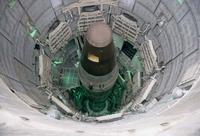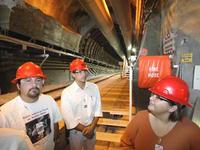-
Radiation detection market to see accelerated growth
The radiation detection industry will see accelerated growth as a result of ongoing homeland security concerns to greater concerns about safety in the nuclear power industry; the growth will involve both increases in the volume of materials required, and in the types of materials being sought
-
-
Radiation fears cripple Japanese food exports

Japanese agricultural exports have yet to recover from the 11 March earthquake and tsunami due largely to fears of radioactive contamination; to combat these fears, local governments have done all they can to assure consumers that their products are safe; consumers remain wary despite these reassurances, and as a result the Japanese agricultural sector is struggling
-
-
First quantitative measurements of Fukushima leakage
Atmospheric chemists report the first quantitative measurement of the amount of radiation leaked from the damaged nuclear reactor in Fukushima; the researchers calculated that 400 billion neutrons were released per square meter surface of the cooling pools, between 13 March, when the seawater pumping operation began, and 20 March 2011
-
-
Cheap radiation detector made of PET resin developed
Researchers develop a revolutionary radiation-sensitive plastic with a performance superior to plastic scintillators used for measuring radiation; the discovery will enable a major reduction in production costs — a step toward an inexpensive radiation detector available to everyone
-
-
Dallas launches regional nuke detectors
The Dallas police will soon be participating in a regional radiological nuclear detection program that will help law enforcement officials detect any anomalies and help protect against any nuclear or radiological attacks
-
-
Underwater nuke detecting drone
Unmanned underwater vehicles (UUV) could soon be prowling the nation’s coastline to detect radiological and nuclear threats; the underwater drones, developed by New Jersey based Princeton Security Technologies, Inc., are equipped with radiological isotope identification hardware to monitor any changes below the water
-
-
Statistics helps calculate uncertainty of aging U.S. nukes

How do you test a not-so-young nuclear stockpile for the effects of age when you cannot detonate any for the sake of finding out? The U.S. government has not conducted live nuclear tests since the early 1990s, but a BYU scientist offers solid answers — based on statistical analysis and without setting off any weapons
-
-
DNDO formally approves Smiths Detection’s RadSeeker
Smiths Detection’s newly launched RdSeeker radiation detection has been formally approved by DHS Domestic Nuclear Detection Office (DNDO) for production and deployment
-
-
U.S. General: troops unprepared for nuke risks in Japan
A U.S. general admitted that U.S. troops stationed in Japan did not have the proper training or equipment to handle radiation exposure in the days immediately following the nuclear crisis at the Fukushima Daiichi power plant caused by the 11 March earthquake and tsunami
-
-
Blue ribbon commission calls for interim off site waste storage

After deciding to stop the Yucca Mountain nuclear waste repository project, President Obama appointed a blue Ribbon commission to examine alternatives; the first report from the commission calls for interim storage of nuclear waste not on the site of nuclear power plants, and for the creation of a new corporation to develop one or more deep geological repositories “as expeditiously as possible”
-
-
Troubled $1.2 billion nuclear detection program cancelled
After news hit that DHS was planning on spending additional money to procure a troubled nuclear detection system that has been plagued with problems, the Obama administration decided to scrap the $1.2 billion program
-
-
Crystals developed to detect chemical and nuclear bombs
Researchers are currently exploring the use of crystals to help detect radioactive materials as well as chemical bombs; using a $900,000 grant awarded by the National Nuclear Security Administration Office’s Nonproliferation Research and Development arm, scientists from Fisk University and Wake Forest University are studying the viability of using strontium iodide crystals to screen cargo containers for dangerous explosives
-
-
Japan halts shipments of radioactive beef
The Japanese government is coming under fire for only halting shipments of contaminated cattle now, four months after the 11 March earthquake and tsunami that led to the nuclear crisis at the Fukushima Daiichi atomic energy station; authorities recently discovered that 637 cattle had been fed hay contaminated with radioactive cesium and then shipped from farms in northern prefectures including Fukushima
-
-
Troubled radiation screening program gets additional $300 million
The Advanced Spectroscopic Portal (ASP) procurement program has hit another snag in its short-lived, yet troubled life; a recent unreleased Government Accountability Office (GAO) found that DHS plans to spend more than $300 million dollars to purchase several hundred ASPs, radiation detection equipment, that has not been fully tested and may not even work at all
-
-
New radiation detector unveiled, does not rely on helium-3
Princeton Security Technologies, Inc. appears to have a solution to the quickly dwindling helium-3 stockpiles; on Tuesday the company announced that it had developed and delivered the first commercially available nuclear materials detector that does not rely on helium-3
-
More headlines
The long view
Keeping the Lights on with Nuclear Waste: Radiochemistry Transforms Nuclear Waste into Strategic Materials
How UNLV radiochemistry is pioneering the future of energy in the Southwest by salvaging strategic materials from nuclear dumps –and making it safe.
Model Predicts Long-Term Effects of Nuclear Waste on Underground Disposal Systems
The simulations matched results from an underground lab experiment in Switzerland, suggesting modeling could be used to validate the safety of nuclear disposal sites.
